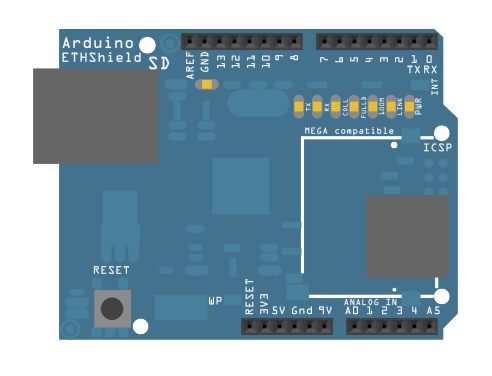Eğitimler
TelnetClient
Bu örnek bir Ethernet kalkanı kullanarak bir Telnet sunucusuna bağlanır. Sunucudan gelen iletiler seri bağlantı noktası üzerinden yazdırılır. Mesajlar uzak sunucuya seri olarak da gönderilebilir. Seri monitör bu amaç için iyi çalışır.
Gerekli Donanım
- Arduino veya Genuino Kurulu
- Arduino Ethernet Kalkanı
Yazılım Gerekli
- Bir telnet sunucusu
- Alternatif olarak, İşleme'nin bu amaç için iyi çalışan bir ChatServer örneği vardır
Devre
Ethernet kalkanı, bir WIZNet Ethernet denetleyicisini SPI veri yolu üzerinden Arduino veya Genuino kartlarına bağlamanızı sağlar. Ethernet denetleyici yongasına SPI bağlantısı için yonga seçimi olarak ICSP başlık pimlerini ve pin 10'u kullanır. Ethernet kalkanının sonraki modellerinde de bir SD Kart bulunur. Dijital pim 4, SD karttaki ikincil seçim pimini kontrol etmek için kullanılır.
Kalkan bir Ethernet kablosuyla bir ağa bağlanmalıdır. Programdaki ağ ayarlarını ağınıza uygun olacak şekilde değiştirmeniz gerekecektir.

Fritzing kullanılarak geliştirilen görüntü . Daha fazla devre örneği için Fritzing proje sayfasına bakın
Yukarıdaki görüntüde, Arduino veya Genuino kartı Ethernet kalkanının altına istiflenecektir.
Kod
/*
Telnet client
This sketch connects to a a telnet server (http://www.google.com)
using an Arduino Wiznet Ethernet shield. You'll need a telnet server
to test this with.
Processing's ChatServer example (part of the network library) works well,
running on port 10002. It can be found as part of the examples
in the Processing application, available at
http://processing.org/
Circuit:
* Ethernet shield attached to pins 10, 11, 12, 13
created 14 Sep 2010
modified 9 Apr 2012
by Tom Igoe
*/
#include
See Also
- Arduino Ethernet Shield- Ürün Açıklaması.
- Getting started with the Ethernet Shield- Her şeyi dakikalar içinde kurun.
- Ethernet library- Ethernet Kütüphanesi için referansınız.
- ChatServer- Gelen iletileri bağlı tüm istemcilere dağıtan basit bir sunucu.
- WebClient- Web'i sorgulayın ve seri monitörden cevap alın
- WebClientRepeating - Ethernet kalkanı kullanılarak tekrarlanan HTTP istekleri nasıl yapılır.
- WebServer- Analog girişin değerini gösteren basit bir web sunucusu.
- DhcpAddressPrinter- Bir DHCP adresi alın ve seri monitöre yazdırın.
- DhcpChatServer- Bir Telnet sunucusuna bağlanın ve alınan tüm mesajları seri monitörde yazdırın; DHCP kullanır.
- BarometricPressureWebServer- SPI kullanarak basınç sensöründen okunan verileri kaydedin.
- UDPSendReceiveString- UDP protokolü (Universal Datagram Packet) aracılığıyla metin dizeleri gönderip alın.
- UdpNtpClient- bir Ağ Zaman Protokolü (NTP) sunucusunu sorgulamak ve seri monitörden bilgi almak.
